Vocabulary for the representation of urban public bus transport data
Release 2021-07-15
- This version:
- http://vocab.ciudadesabiertas.es/def/transporte/autobus/1.1.0
- Revision:
- Version 1.0.1 of the Bus ontology that has been implemented in the context of the project Ciudades Abiertas: Plataforma de gobierno abierto, colaborativa e interoperable in which the city councils of Madrid, Zaragoza, Santiago de Compostela and A Coruña participate.
- Authors:
- Adolfo Antón Bravo (Ontology Engineering Group - Universidad Politécnica de Madrid)
- Edna Ruckhaus (Ontology Engineering Group - Universidad Politécnica de Madrid)
- Oscar Corcho (Ontology Engineering Group - Universidad Politécnica de Madrid, Localidata)
- Paola Espinoza Arias (Ontology Engineering Group - Universidad Politécnica de Madrid)
- Contributors:
- Andrés Iglesias Pardo - Empresa Municipal de Transportes de Madrid
- Andrés Recio Martín - Empresa Municipal de Transportes de Madrid
- Honorio Enrique Crespo Díaz-Alejo - Ayuntamiento de Madrid
- José Antonio Chanca Cáceres - Ayuntamiento de Zaragoza
- María Carmen Ruiz Moreno - Ayuntamiento de Madrid
- María Jesús Fernández Ruiz - Ayuntamiento de Zaragoza
- María Jesús Gallego San Miguel - Ayuntamiento de Madrid
- María del Mar Arribas de Andrés - Ayuntamiento de Madrid
- Red.es
- Servicio de Informática - Ayuntamiento de Santiago de Compostela
- Servicio de Innovación y Desarrollo Tecnológico - Ayuntamiento de A Coruña
- Víctor Morlán Pío - Ayuntamiento de Zaragoza
- Publisher:
- Ontology Engineering Group - Universidad Politécnica de Madrid
- Download serialization:
- License:
- Evaluation:
- Cite as:
- Adolfo Antón Bravo (Ontology Engineering Group - Universidad Politécnica de Madrid),Edna Ruckhaus (Ontology Engineering Group - Universidad Politécnica de Madrid),Oscar Corcho (Ontology Engineering Group - Universidad Politécnica de Madrid, Localidata),Paola Espinoza Arias (Ontology Engineering Group - Universidad Politécnica de Madrid). Vocabulary for the representation of data on public transport by bus.. Revision: Versión 1.0 de la ontología de Autobús que ha sido implementada en el contexto del proyecto Ciudades Abiertas: Plataforma de gobierno abierto, colaborativa e interoperable en la que participan los ayuntamientos de Madrid, Zaragoza, Santiago de Compostela y A Coruña. Retrieved from: http://vocab.ciudadesabiertas.es/def/transporte/autobus/1.0.1
Abstract
This vocabulary has been developed in the context of the action on open data of the project "Platform of Open, Collaborative and Interoperable Government" of the "II Call for Intelligent Cities" of the Ministry of Economy and Enterprise launched through the Public Business Entity Red.es assigned to the Secretariat of State for Digital Advancement of that ministry.- 1. Introduction
- 2. Overview
- 3. Description
- 4. Classes, Object properties, data properties and individuals.
- 4.1 Classes
- 4.2 Object Properties
- 4.3 Data Properties
- 4.4 Individuals
- 5. References
- 6. Acknowledgements
Introduction back to ToC
This vocabulary represents the information of the urban bus public transport system. The transport systems of the four cities participating in the Open Cities project (A Coruña, Madrid, Santiago de Compostela and Zaragoza) have been analysed, as well as other cities with open data publication policies.
The international standard TransModel which contains the model for the exchange of transport information between companies, operators or transport authorities of the European Union member states has been taken into account. In addition, according to regulation 2017/1926 which follows the European directive 2010 on intelligent transport services ITS (Intelligent Transport System) any authority, operator or company of land transport services must offer their data in formats compatible with Transmodel from December 2019.
During 2019 OEG-UPM has participated in the project SNAP to facilitate the compliance with the legislation through the conversion or generation of GTFS data in NeTeX, the Transmodel format, through the development of the ontology Transmodel, which has been taken into account for the development of this vocabulary. In general the following Transmodel concepts have been reused: Operator, Authority, Line, Route, Points on a Route, Trip Pattern, Points on a Trip Pattern, Stop, Trip associated to a Trip Pattern, Trip Schedules and Frequencies and Service Calendar. This vocabulary is related to the concept of Incidence in the Traffic vocabulary developed in the context of this project and also to the Postal Address and geosparql. The vocabulary has been divided into three main parts: (1) Operator and its lines, (2) Routes and stops and (3) TravelNamespace declarations
esautob <http://vocab.ciudadesabiertas.es/def/transporte/autobus#> schema <http://schema.org> direccion-postal <http://vocab.linkeddata.es/datosabiertos/def/urbanismo-infraestructuras/direccion-postal> tmkosjourney <http://w3id.org/transmodel/kos/journeys> owl <http://www.w3.org/2002/07/owl> esautob <http://vocab.ciudadesabiertas.es/def/transporte/autobus> tmcommons <http://w3id.org/transmodel/commons> xsd <http://www.w3.org/2001/XMLSchema> skos <http://www.w3.org/2004/02/skos/core> rdfs <http://www.w3.org/2000/01/rdf-schema> sosa1 <http://www.w3.org/ns/sosa> geo <http://www.w3.org/2003/01/geo/wgs84_pos> sf <http://www.opengis.net/ont/sf> dct <http://purl.org/dc/terms> xml <http://www.w3.org/XML/1998/namespace> vann <http://purl.org/vocab/vann> tmorg <http://w3id.org/transmodel/organisations> sosa <http://w3.org/ns/sosa> tmjourney <http://w3id.org/transmodel/journeys> org <http://www.w3.org/ns/org> vcard <http://www.w3.org/2006/vcard> trafico <http://vocab.linkeddata.es/datosabiertos/kos/transporte/trafico> geosparql <http://www.opengis.net/ont/geosparql> rdf <http://www.w3.org/1999/02/22-rdf-syntax-ns> estraf <http://vocab.ciudadesabiertas.es/def/transporte/trafico> geocore <https://datos.ign.es/def/geo_core> escjr <http://vocab.linkeddata.es/datosabiertos/def/urbanismo-infraestructuras/callejero> tmkoscommons <http://w3id.org/transmodel/kos/commons> dc <http://purl.org/dc/elements/1.1>
Overview back to ToC
This ontology has the following classes and properties.
Classes
- Authority
- Bus Line
- Concept
- Concept Scheme
- Contact Details
- Contact Point
- DayType
- DayTypeAssignment
- Destination Display
- Feature
- Feature Of Interest
- Geographic Point
- Geometry
- Headway Interval
- Headway Journey Group
- Incidence
- JourneyPattern
- Line
- Link Sequence
- Observation
- Operator
- Organisation
- Organization
- Place
- Planned incidence
- Point
- Point In Journey Pattern
- Point in Link Sequence
- Point on Route
- Postal Address
- Presentation
- Route
- Route Point
- Scheduled Stop Point
- Sensor
- ServiceCalendar
- Spatial Object
- Stop Area
- Stop Place
- Stop Point In Journey Pattern
- Timing Point In Journey Pattern
- VehicleJourney
- Waiting Time
- Zone
Object Properties
- asWKT
- characterised by
- composed of
- Contact Point
- defined By
- determined By
- Direction Type
- functionalCentroidFor
- Has Address
- has Feature Of Interest
- hasGeometry
- Included In
- It is in Scheme
- JourneyPattern generated by an Incidenceline affected by an incidence
- line affected by an incidence
- Line End Stop Point
- Line Head Stop Point
- made by sensor
- made Up Of
- made Using
- observed property
- observes
- on
- operating
- Prescribing
- presented by
- Serving Public Transport For
- specifying
- stop Use
- timedFrom
- viewed As
- worked On
Data Properties
- (expected) end date
- (expected) start date
- attached to incidence
- colour
- Date
- Date created
- Date posted
- Departure Time
- Description
- Distance
- Distance from start
- Earliest Time
- Electronic Information Panel
- end date
- Expected Arrival Time
- First departure time
- for Alighting
- for Boarding
- from
- Front Text
- Identifier
- Is Available
- Journey Duration
- Last day offset
- last departure time
- latitude
- longitude
- Maximum Headway Interval
- Minimum Headway Interval
- Nombre
- Nombre alternativo
- Nombre legal
- Order
- Phenomenon Time
- Recurrence
- Recurrent incidence
- Scheduled Headway Interval
- Short Name
- Street directions
- Telephone
- text colour
- to
- Traffic lanes
- URL
- WiFi
- xETRS89
- yETRS89
- Zone
Named Individuals
Description back to ToC
This vocabulary represents the information of the urban public bus service which includes the authorities and transport operators, the lines of the urban public bus service, the routes of the lines, the stops and the incidents of the service
The scope of this vocabulary is defined in two types of information:
- Information on lines and stops (routes, number of stops, etc.)
- Real-time information (time of arrival of the bus at the stop, time forecast during the journey, etc.)
Figure 1 shows the classes and properties of the traffic vocabulary. The main objective of this vocabulary is to allow the representation of the public urban bus service, both its lines and routes or its incidents.
In the upper right side it is shown the org pattern since the class org:Organization of that vocabulary is reused for the Transmodel vocabulary which is a vocabulary specifically supported by this bus and which makes it compatible with the European standard for land transport data exchange.
From the Transmodel vocabulary set we reuse tmorg referring to the organizations that have a role in the public transport system; from tmjourney that deals with the aspects of travel; and from tmcommons that addresses the common concepts.
In this case, tmorg:Organisation is a subclass of org:Organization which has the subclasses tmorg:Operator for transport operators and tmorg:Authority for transport authorities.
It is the operator company that operates a tmjourney:Line, in this case the new subclass esautob:Line has been created to relate them to the incidents estraf:Incidencia of the traffic vocabulary through the property esautob:afectadaPorIncidencia.
The lines are composed of tmjourney:madeUpOf routes tmjourney:Route, which is where the journey patterns tmjourney:JourneyPattern work on tmjourney:on.
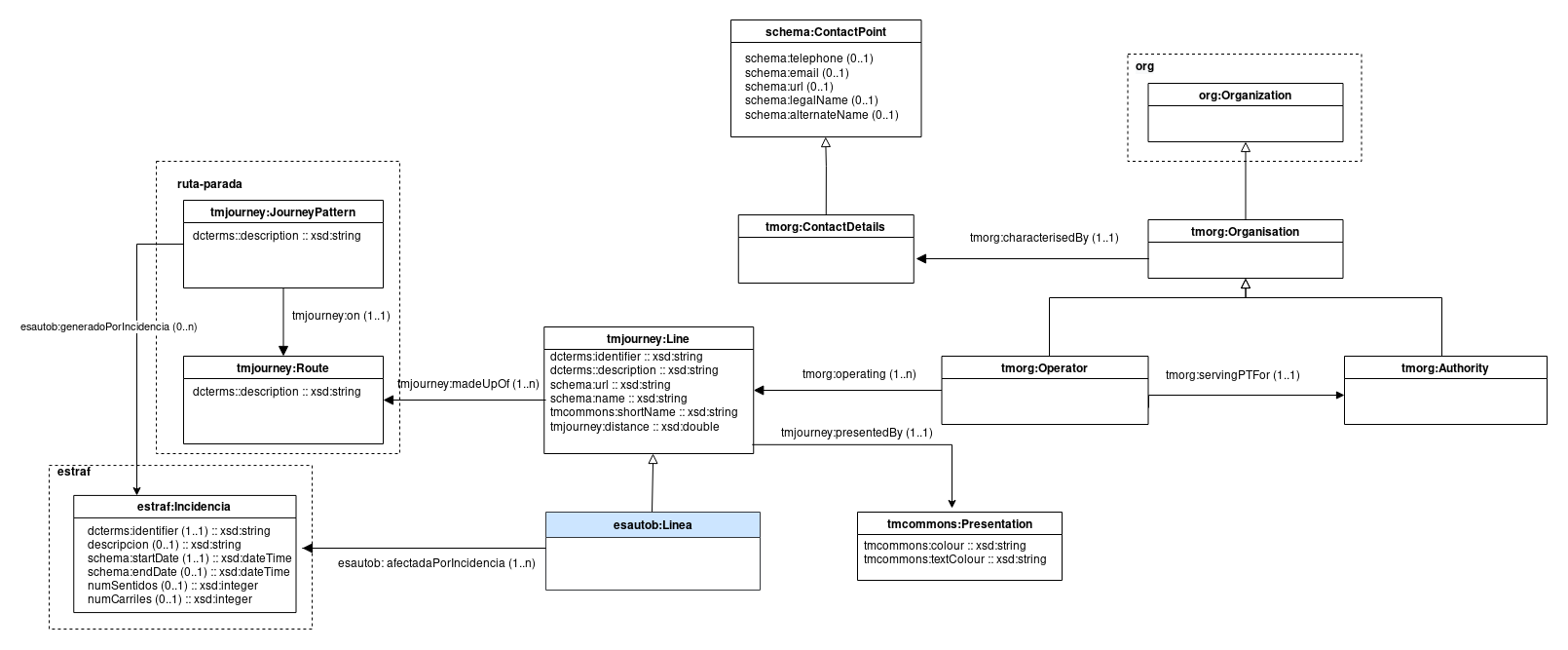
Link Sequenceback to índice
One of the richest concepts in Transmodel is routes. To explain this, this diagram shows how the information on a route is represented. As it appeared in the previous diagram, a journey pattern tmjourney:JourneyPattern works in a Route tmjourney:Route. But in addition, both classes are subclasses of a sequence of links tmjourney:LinkSequence.
The tmjourney:LinkSequence are made up of tmjourney:madeUpOf points in link sequences tmjourney:PointInLinkSequence, that can be viewed as tmjourney:viewedAs points tmjourney:Point, which are functional centroid for a zone tmcommons:Zone, class of which will be subclass tmcommons:Place of which is subclass itself the created class for a Stop esautob:Parada.
On each side of this trunk line the route relations are developed tmjourney:Route, with Poin on Route tmjourney:PointOnRoute and Route Point tmjourney:RoutePoint on one side and Stop Point In Journey Pattern tmjourney:StopPointInJourneyPattern and Scheduled Stop Point tmjourney:ScheduledStopPoint on the other side.
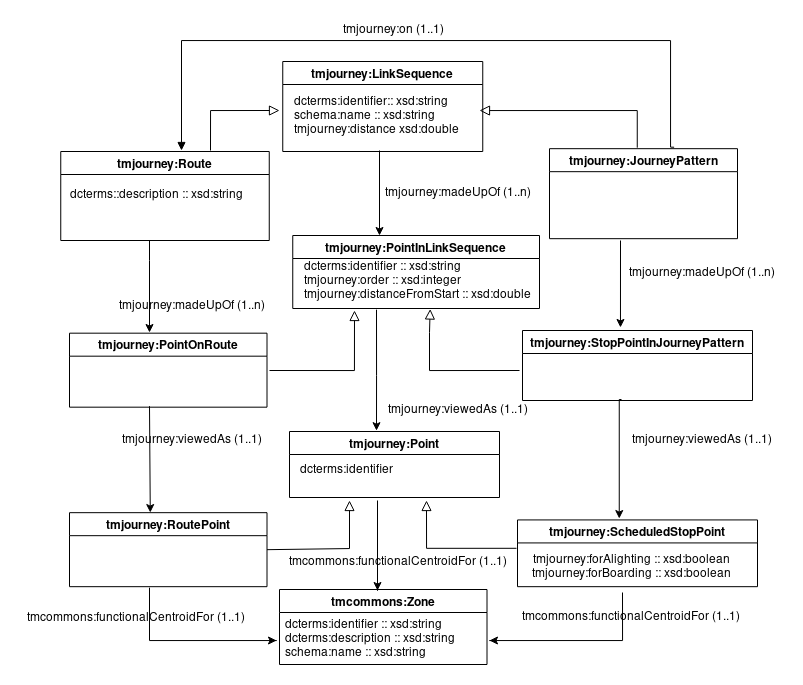
Stopback to índice
A Zone tmcommons:Zone is a superclass of Place tmcommons:Place and this in turn of the new created class Parada esautob:Parada. The esautob:Parada has an address schema:address that it is related to the Postal Address class escjr:DireccionPostal of the vocabulary of streets escjr.
Also one Line esautob:Linea is related to esautob:Parada through the creted properties bus line header esautob:cabeceraLinea and end of bus line esautob:finalLinea.
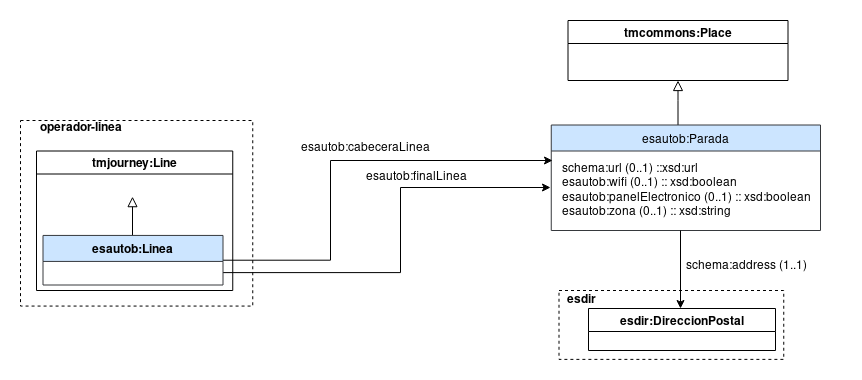
geo patternback to índice
Moreover, the Stop esautob:Parada, as a subclass of geosparql:Feature, it is related with the pattern of geolocalisation made up of the following vocabularies: geo, sf, geo_core and geosparql and gets the geolocalisation through the property geosparql:hasGeometry that relates it with the geographical point sf:Point as a subclass of geosparql:Geometry. The coordinates, longitude and latitude in WGS84 and ETRS89 format are attributes of this geographical Point sf:Point.
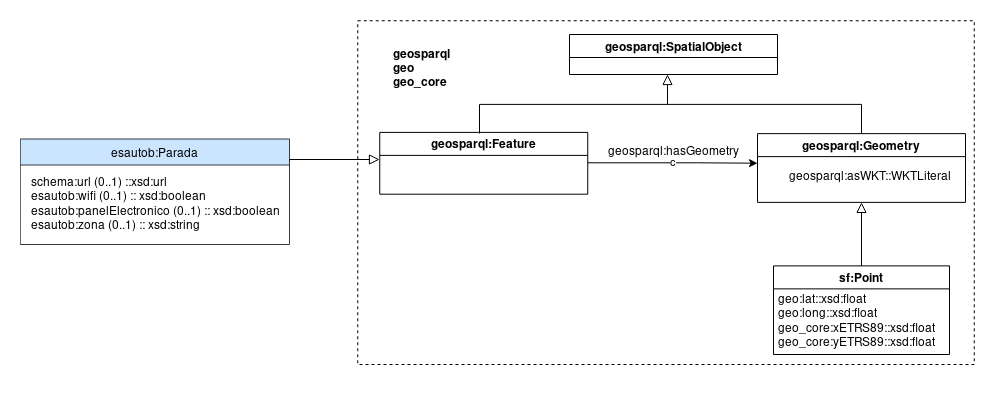
SOSA Patternback to índice
To represent the passing time of the next vehicle it has been created the new class esautob:RealTimePassingTime that, as a subclass of sosa:Observation has the feature of interest sosa:hasFeatureOfInterest the point in link sequence tmjourney:PointInLinkSequence, the superclass of Route tmjourney:Route and tmjourney:JourneyPattern.
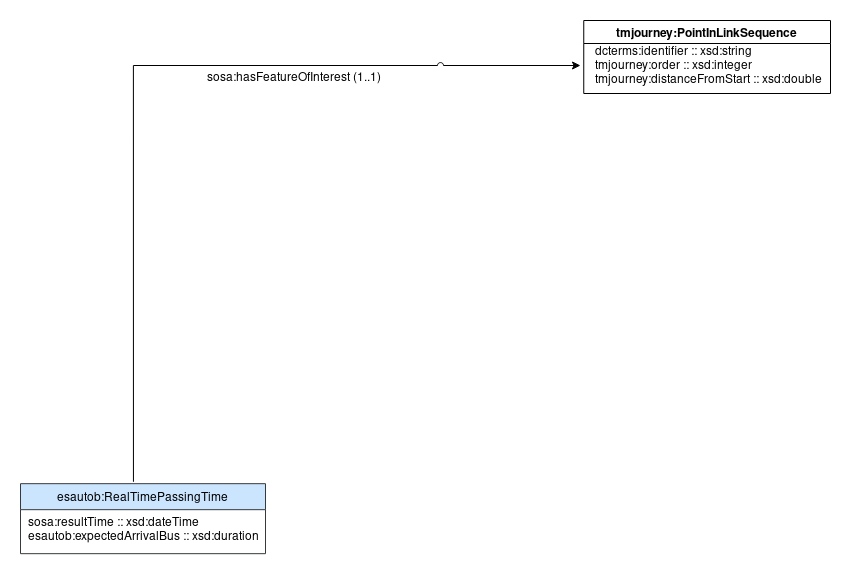
Vehicle Journeyback to toc
In addition to line, route and journey pattern, in Transmodel there is a concept called Vehicle Journey tmjourney:VehicleJourney that represents the journey schema of the vehicle as an abstraction using tmjourney:madeUsing journey patterns tmjourney:JourneyPattern.
Its direction tmjourney:directionType is set by a traxonomy called direction-type tmkosjourney:direction-type of the project Transmodel.
The vehicle journey tmjourney:VehicleJourney can take the times from tmjourney:timedFrom a timing point in journey pattern tmjourney:TimingPointInJourneyPattern, that is a subclass of a point in link sequence tmjourney:PointInLinkSequence.
Each one is composed of tmjourney:composedOf of a group of headway journey group tmjourney:HeadwayJourneyGroup that is determined by tmjourney:determinedBy a headway interval tmjourney:HeadwayInterval. Each one worked on tmjourney:workedOn a day type tmjourney:DayType.
Finally, a service calendar tmjourney:ServiceCalendar sets a starting date tmjourney:from and an ending date tmjourney:to and it is defined by tmjourney:definedBy a day type assignation tmjourney:DayTypeAssignment that sets a date tmjourney:date and specifies a day type tmjourney:DayType.
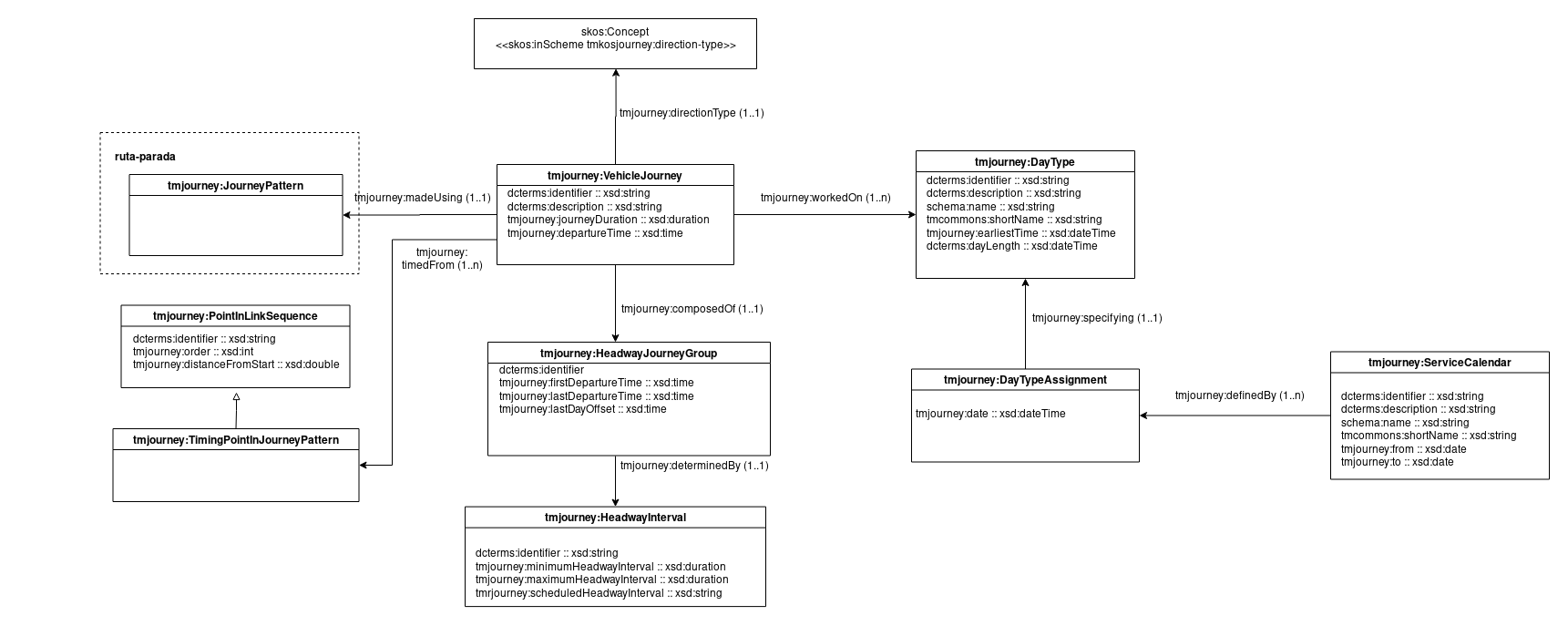
Examples
In order to facilitate the understanding of the use of some classes and properties of this vocabulary, some examples are provided below:
Contact Details
In order to represent the contact details of the Operator or the Authority an instance of the class tmorg:ContactDetails is created.
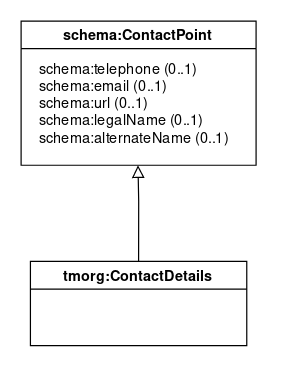
It has the following properties:
- A telephone schema:telephone.
- An email schema:email.
- An URL schema:url.
- A postal address schema:address.
- A legal name schema:legalName.
- And finally, an alternate name schema:alternateName, by which it is known.
Example of the contact detail of the Operator EMT:
<http://vocab.ciudadesabiertas.es/recurso/transporte/autobus/contactdetails/emt> a tmorg:ContactDetails ;
schema:telephone "+34 91 406 88 10"^^xsd:string ;
schema:email "https://www.emtmadrid.es/AtencionAlCliente/Agradecimientos"^^xsd:string ;
schema:url "https://www.emtmadrid.es/Servicios/Contactar"^^xsd:anyURI ;
schema:address "Empresa Municipal de Transportes, Calle Cerro de la Plata, 4. 28007 Madrid"^^xsd:string ;
schema:legalName "Empresa Municipal de Transportes"^^xsd:string ;
schema:alternateName "EMT"^^xsd:string .
Line
One of the lines of the Operator EMT is the 138. In order to represent its information an instsance of the new class esautob:Linea is created.

Linea has the following properties:
- Its identifier dcterms:identifier is the name of the line, in this case 138.
- Its description dcterms:description explins the name and/or number of the line, the headway and the end.
- It may have an URL schema:url.
- Its name schema:name, in this case "Línea 138".
- But also a short name tmjourney:shortNamewhich is sometimes more used than the name, 138.
- The esautob:Linea is presented with a tmcommons:Presentation.
- It may be affeced esautob:afectadaPorIncidencia by some incidences estraf:Incidencia.
- Each line has some stops esautob:Parada identified as head of line esautob:cabeceraLinea and end of line esautob:finLinea.
- Finally, each line is made up of tmjourney:madeUpOf several Routes tmjourney:Route, usually to and back from.
<http://vocab.ciudadesabiertas.es/recurso/transporte/autobus/linea/138> a esautob:Linea ;
dcterms:identifier "138"^^xsd:string ;
dcterms:description "Línea 138, comienzo en Cristo Rey y final en San Ignacio de Loyola"^^xsd:string ;
schema:url "https://www.emtmadrid.es/Bloques-EMT/EMT-BUS/Mi-linea-(1).aspx?linea=138&lang=es-ES"^^xsd:anyURI ;
schema:name "Línea 138"^^xsd:string ;
tmjourney:shortName "138"^^xsd:string ;
tmjourney:presentedBy <http://vocab.ciudadesabiertas.es/recurso/transporte/autobus/presentation/110> ;
esautob:afectadaPorIncidencia <http://vocab.ciudadesabiertas.es/recurso/transporte/trafico/incidencia/29059944-382A-49AA-A068-B55BF2FAC51F> ;
esautob:afectadaPorIncidencia <http://vocab.ciudadesabiertas.es/recurso/transporte/trafico/incidencia/51960FE2-42D7-4B2F-88B0-3774B40E1770> ;
esautob:afectadaPorIncidencia <http://vocab.ciudadesabiertas.es/recurso/transporte/trafico/incidencia/97D969D4-1F48-43B2-AF0B-81DF579C2660> ;
esautob:afectadaPorIncidencia <http://vocab.ciudadesabiertas.es/recurso/transporte/trafico/incidencia/9583B9E9-A82B-4A47-8F8B-4BAA95B50788> ;
esautob:cabeceraLinea <http://vocab.ciudadesabiertas.es/recurso/transporte/autobus/parada/4608> ;
esautob:finLinea <http://vocab.ciudadesabiertas.es/recurso/transporte/autobus/parada/5481> ;
tmjourney:madeUpOf <http://vocab.ciudadesabiertas.es/recurso/transporte/autobus/route/138a> ;
tmjourney:madeUpOf <http://vocab.ciudadesabiertas.es/recurso/transporte/autobus/route/138b> .
The presentation of Line is an instance of the class tmcommons:Presentation that has just two properties:
- The background colour tmcommons:colour.
- And the text colour tmcommons:textColour.
<http://vocab.ciudadesabiertas.es/recurso/transporte/autobus/presentation/210> a tmcommons:Presentation ;
tmcommons:colour "Azul"^^xsd:string ;
tmcommons:textColour "Negro"^^xsd:string .
Incidence
In order to represent the incidences it is reused the estraf:Incidencia from the traffic vocabulary.
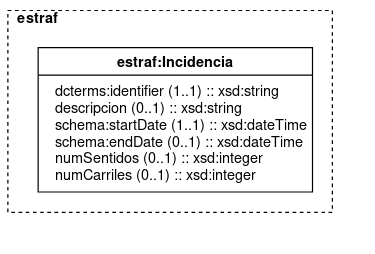
An instance is created with the following properties:
- The URI is created using the identifier dcterms:identifier.
- Its description dcterms:description.
- A title dcterms:title is a sort of short description.
- For more information it can be linked a document through esautob:incidenciaAdjunto that points to the URL of the incidence in the website, for instance.
- It has a creation date schema:dateCreated, a start date schema:startDate and an end date schema:endDate.
- This property estraf:esRecurrente indicates if it is recurrent or not. For instance a weekly street market.
- The number of directions it may affect is indicated through estraf:numSentidos; the number of lanes through estraf:numCarriles.
- For its geolocalisation, as a subclass of geosparql:Feature, it has the property geosparql:hasGeometry that points to the geographic point sf:Point.
- This incidence can be performed estraf:incidenciaEnTramo in some sections estraf:Tramo. of the city.
- Finally, it can be a type of incidence estraf:tipoIncidencia that points to its taxonomy estrafkos:tipo-incidencia.
<http://vocab.ciudadesabiertas.es/recurso/transporte/trafico/incidencia/29059944-382A-49AA-A068-B55BF2FAC51F> a estraf:Incidencia ;
dcterms:identifier "29059944-382A-49AA-A068-B55BF2FAC51F"^^xsd:string ;
dcterms:description "El 21 de junio de 12:00 a 14:30 horas aproximadamente, las líneas 001, 002, 1, 2, 3, 7, 21, 37, 40, 44, 46, 62, 82, 83, 132, 133, 138, 147, 149, C1 y C2, tendrán retenciones (...)"^^xsd:string ;
dcterms:title "Manifestación Génova - Moncloa 21/06/2020"^^xsd:string ;
esautob:incidenciaAdjunto "http://feeds.emtmadrid.es:8082/docs/20200621-Manifestacion-Genova-Moncloa.pdf"^^xsd:anyURI ;
schema:dateCreated "2020-06-20T09:30:00+02:00"^^xsd:dateTime ;
schema:startDate "2020-06-21T12:00:00+02:00"^^xsd:dateTime ;
schema:endDate "2020-06-21T14:30:00+02:00"^^xsd:dateTime ;
estraf:esRecurrente "false"^^xsd:boolean ;
estraf:numSentidos "2"^^xsd:integer ;
estraf:numCarriles "2"^^xsd:integer ;
geosparql:hasGeometry <http://vocab.ciudadesabiertas.es/recurso/transporte/trafico/point/1865> ;
estraf:incidenciaEnTramo <http://vocab.ciudadesabiertas.es/recurso/transporte/trafico/Tramo/1865> ;
estraf:tipoIncidencia <http://vocab.linkeddata.es/datosabiertos/kos/transporte/trafico/tipo-incidencia/evento> .
Routes
Each Line esautob:Linea usually has at least two Routes tmjourney:Route, although it might have just one or more than two. The outbound Route goes from the head-of-line to the end of line and the return route in the opposite direction. The routes mark the base itineraries, then the journey patterns tmjourney:JourneyPattern may define more itineraries.
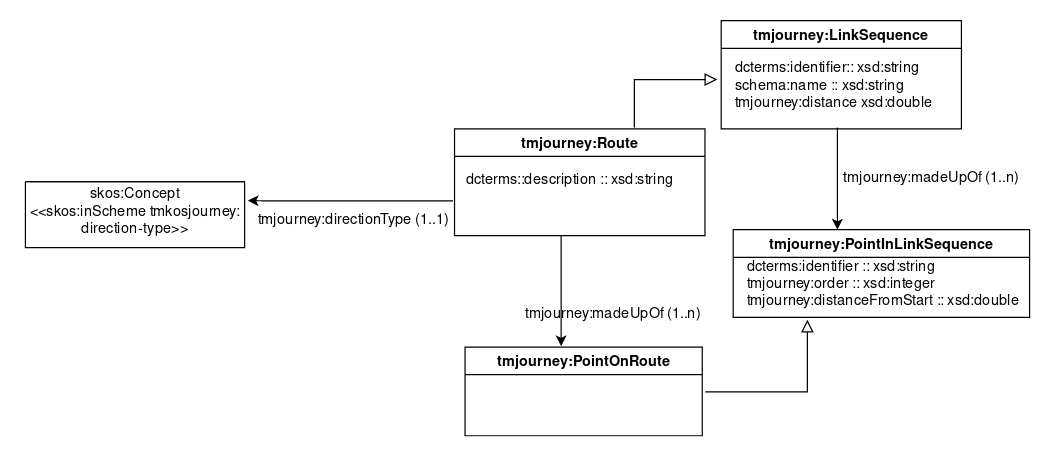
Its properties are:
- An identifier dcterms:identifier that might be the name of the line and the first line of the alphabet.
- A description dcterms:description where is indicated whether it is a one-way, return or other route.
- It is made up of tmjourney:madeUpOf a sucession of points on route tmjourney:PointOnRoute that will correspond to the stops.
- To point out its direction it is used the property tmjourney:directionType which links with the taxonomy of directions. In this case is tmkosjourney:outbound that indicates that the route goes from the head-of-line to the end of line.
The outbound route:
<http://vocab.ciudadesabiertas.es/recurso/transporte/autobus/route/138a> a tmjourney:Route ;
dcterms:identifier "138a"^^xsd:string ;
dcterms:description "Ruta de ida de la línea 138 con inicio en Cristo Rey y destino en San Ignacio de Loyola"^^xsd:string ;
tmjourney:directionType <http://w3id.org/transmodel/kos/journeys/direction-type/outbound> ;
tmjourney:madeUpOf <http://vocab.ciudadesabiertas.es/recurso/transporte/autobus/pointonroute/138a-4608> ;
tmjourney:madeUpOf (...) ;
tmjourney:madeUpOf <http://vocab.ciudadesabiertas.es/recurso/transporte/autobus/pointonroute/138a-5481> .
The inbound route of the Line 138, from the end of line to the head-of-line:
<http://vocab.ciudadesabiertas.es/recurso/transporte/autobus/route/138b> a tmjourney:Route ;
dcterms:identifier "138b"^^xsd:string ;
dcterms:description "Ruta de vuelta de la línea 138 con inicio en San Ignacio de Loyola y destino en Cristo Rey"^^xsd:string ;
tmjourney:directionType <http://w3id.org/transmodel/kos/journeys/direction-type/inbound> ;
tmjourney:madeUpOf <http://vocab.ciudadesabiertas.es/recurso/transporte/autobus/pointonroute/138b-5481> ;
tmjourney:madeUpOf (...) ;
tmjourney:madeUpOf <http://vocab.ciudadesabiertas.es/recurso/transporte/autobus/pointonroute/138b-4608> .
PointOnRoute and RoutePoint
The Point on Route tmjourney:PointOnRoute which is part of a Route tmjourney:Route is subclass of the point in link sequence tmjourney:PointInLinkSequence, from where the properties order tmjourney:order and distance from start tmjourney:distanceFromStart are inherited.
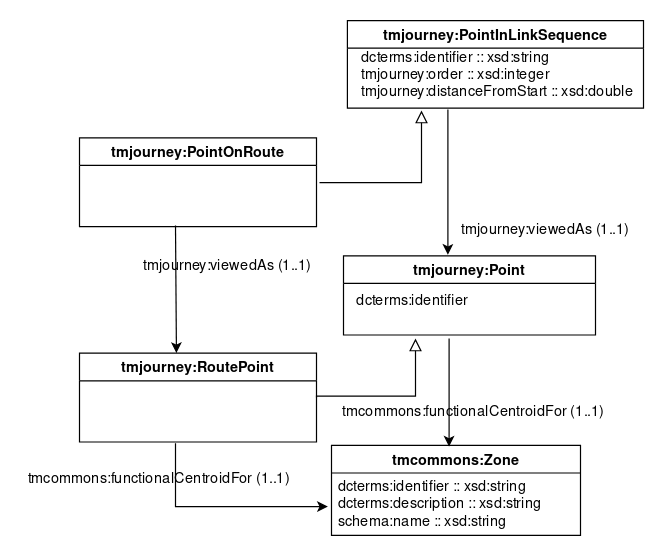
Each instance of tmjourney:PointOnRoute it is represented by:
- An identifier dcterms:identifier that is used to build the URI.
- The order tmjourney:order of the tmjourney:PointOnRoute.
- The distance from start tmjourney:distanceFromStart of the Route in meters.
- The relationship with Route Point tmjourney:RoutePoint it is performed through the property tmjourney:viewedAs, which is a way to communicate the points on route with a physical point.
<http://vocab.ciudadesabiertas.es/recurso/transporte/autobus/pointonroute/138b-4608> a tmjourney:PointOnRoute ;
dcterms:identifier "138b-4608"^^xsd:string ;
tmjourney:order "1"^^xsd:integer ;
tmjourney:distanceFromStart "0"^^xsd:double ;
tmjourney:viewedAs <http://vocab.ciudadesabiertas.es/recurso/transporte/autobus/routepoint/138b-4608> .
<http://vocab.ciudadesabiertas.es/recurso/transporte/autobus/pointonroute/138b-4022> a tmjourney:PointOnRoute ;
dcterms:identifier "138b-4022"^^xsd:string ;
tmjourney:order "2"^^xsd:integer ;
tmjourney:distanceFromStart "247"^^xsd:double ;
tmjourney:viewedAs <http://vocab.ciudadesabiertas.es/recurso/transporte/autobus/routepoint/138b-4022> .
The Route Point tmjourney:RoutePoint establishes the relationship between the Point On Route with the physical point, that is, the stops esautob:Parada, as the points on route are functional centroid for tmcommons:functionalCentroidFor a zone tmcommons:Zone which is a superclass of Place tmcommons:Place which in turn is a superclass of Stop, as it is explained below
<http://vocab.ciudadesabiertas.es/recurso/transporte/autobus/routepoint/138b-4608> a tmjourney:RoutePoint ;
tmcommons:functionalCentroidFor <http://vocab.ciudadesabiertas.es/recureso/transporte/autobus/parada/4608> .
JourneyPattern and DestinationDisplay
The Journey Pattern tmjourney:JourneyPattern works on tmjourney:on a Route tmjourney:Route. Both classes are subclasses of Link Sequence tmjourney:LinkSequence. It is made up of tmjourney:madeUpOf stop point in journey patterns tmjourney:StopPointInJourneyPattern which are subclasses of Point In Link Sequences tmjourney:PointInLinkSequence. Its destination is announced through the relationship tmjourney:prescribing in a destination display tmjourney:DestinationDisplay.
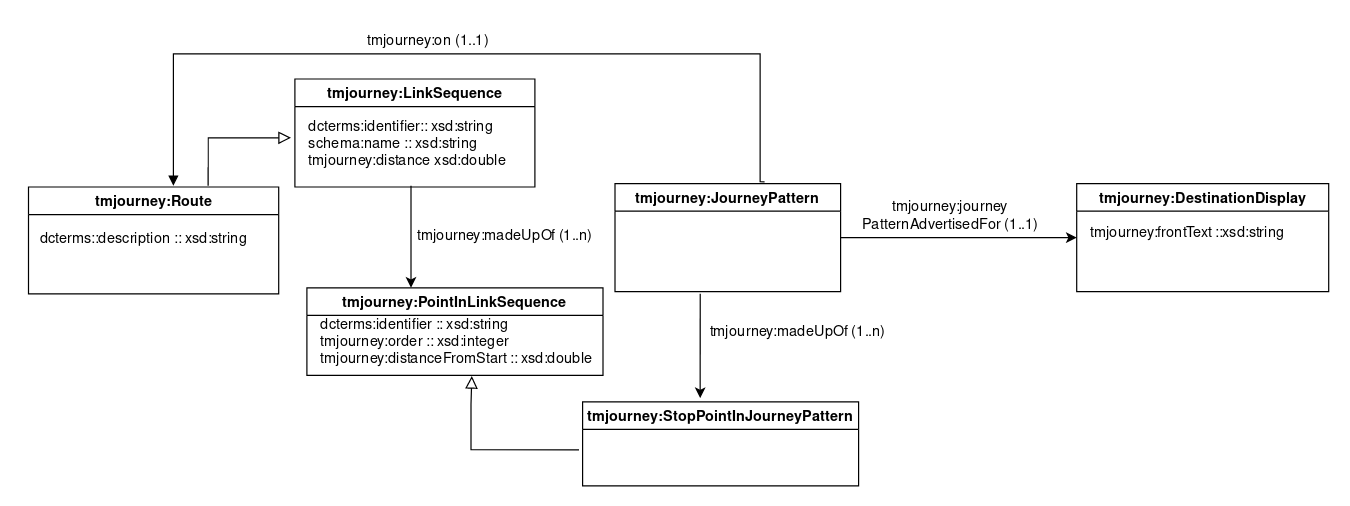
<http://vocab.ciudadesabiertas.es/recurso/transporte/autobus/journeypattern/138a2> a tmjourney:JourneyPattern ;
dcterms:identifier "138a2"^^xsd:string ;
schema:name "138a2"^^xsd:string ;
tmjourney:distance "11,194"^^xsd:double ;
tmjourney:on <http://vocab.ciudadesabiertas.es/recurso/transporte/autobus/route/138a> ;
tmjourney:prescribing <http://vocab.ciudadesabiertas.es/recurso/transporte/autobus/destinationdisplay/138a1> ;
esautob:generadoPorIncidencia <http://vocab.ciudadesabiertas.es/recurso/transporte/trafico/incidencia/29059944-A068-B55BF2FAC51F> ;
tmjourney:madeUpOf <http://vocab.ciudadesabiertas.es/recurso/transporte/autobus/stoppointinjourneypattern/138a1-4608> ;
tmjourney:madeUpOf <http://vocab.ciudadesabiertas.es/recurso/transporte/autobus/stoppointinjourneypattern/138a1-5481> .
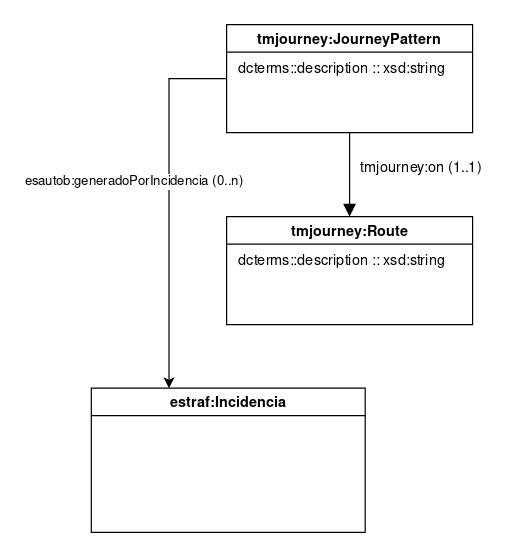
StopPointInJourneyPattern
The Journey Patterns tmjourney:JourneyPattern are made up of tmjourney:madeUpOf stop points in journey patterns tmjourney:StopPointInJourneyPattern which are subclass of points in link sequences tmjourney:PointInLinkSequence. As suche, they can be viewed as tmjourney:viewedAs scheduled stop points tmjourney:ScheduledStopPoint.
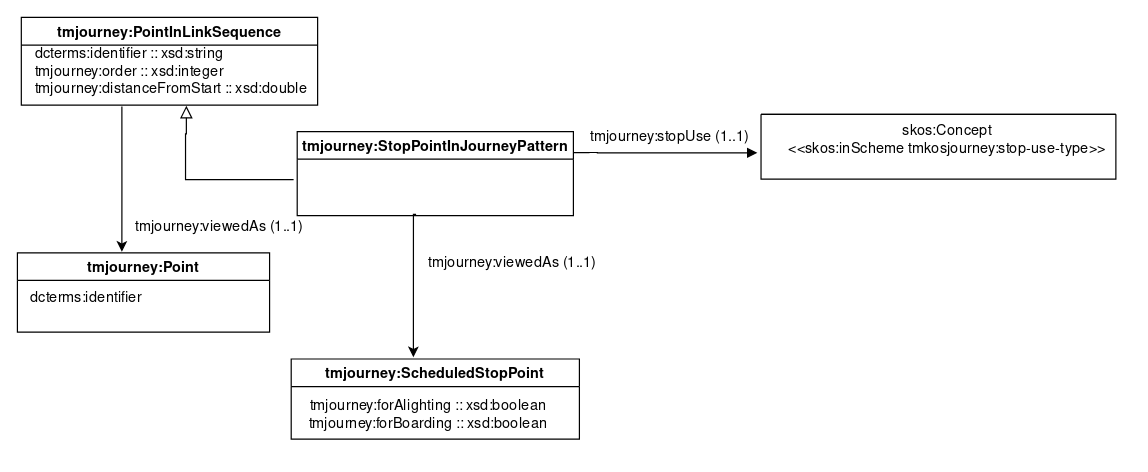
The type of use is set through the relationship stop use tmjourney:stopUse with the vocabulary stop use type tmkosjourney:stop-use-type. In this case it is a pass through tmkosjourney:pass-through stop.
It inherits from Point In Link Sequence tmjourney:PointInLinkSequence the identifier dcterms:identifier, the order tmjourney:order of that point in the link sequence tmjourney:LinkSequence which is the Journey Pattern tmjourney:JourneyPattern and the distance from start tmjourney:distanceFromStart of this sequence.
<http://vocab.ciudadesabiertas.es/recurso/transporte/autobus/stoppointinjourneypattern/138a1-4608> a tmjourney:StopPointInJourneyPattern ;
dcterms:identifier "138a1-4608"^^xsd:string ;
tmjourney:order "1"^^xsd:integer ;
tmjourney:stopUse <http://w3id.org/transmodel/kos/journeys/stop-use-type/pass-through> ;
tmjourney:viewedAs <http://vocab.ciudadesabiertas.es/recurso/transporte/autobus/scheduledstoppoint/138a1-4608> .
ScheduledStopPoint
The Scheduled Stop Point tmjourney:ScheduledStopPoint, as a subclass of the Point tmjourney:Point, is the functional centroid for tmcommons:functionalCentroidFor a Zone tmcommons:Zone, which is the superclass of Place #tmcommons:Place which is in turn the superclass of Parada esautob:Parada.

Their properties are:
- An identifier dcterms:identifier that is used to make up the URI.
- Two properties indicate whether the stop can be use for alighting tmjourney:forAlighting or for boarding tmjourney:forBoarding the bus.
- It may be included tmjourney:included in a Stop Area tmjourney:StopArea·
<http://vocab.ciudadesabiertas.es/recurso/transporte/autobus/schedulestoppoint/138a1-4608> a tmjourney:ScheduledStopPoint ;
tmjourney:includedIn <http://vocab.ciudadesabiertas.es/recurso/transporte/autobus/stoparea/cristorey> ;
tmcommons:functionalCentroidFor <http://vocab.ciudadesabiertas.es/recurso/transporte/autobus/parada/4608> ;
tmjourney:forAlighting "false"^^xsd:boolean ;
tmjourney:forBoarding "true"^^xsd:boolean .
<http://vocab.ciudadesabiertas.es/recurso/transporte/autobus/stoparea/cristorey> a tmjourney:StopArea ;
dcterms:id "cristorey"^^xsd:string ;
dcterms:name "Cristo Rey"^^xsd:string .
Stop, Zone, Place
A Zone tmcommons:Zone is the superclass of Place tmcommons:Place and this in turn of Parada esautob:Parada.
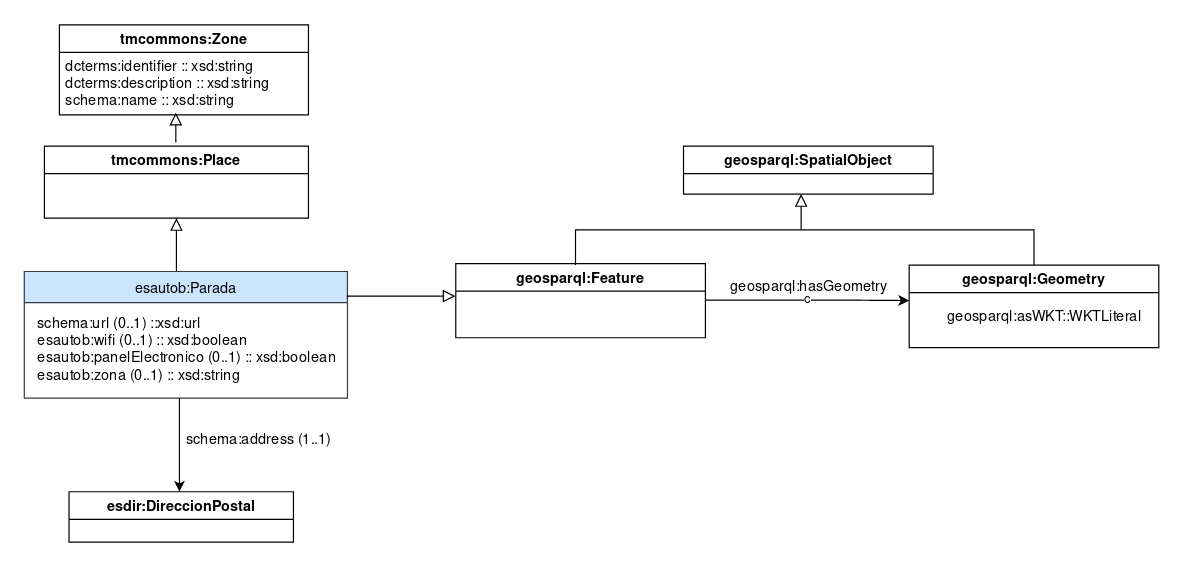
<http://vocab.ciudadesabiertas.es/recurso/transporte/autobus/parada/3086> a esautob:Parada , tmcommons:Place, tmcommons:Zone ;
schema:url "https://emtmadrid.es/paradas/#"^^xsd:anyURI ;
dcterms:id "3086"^^xsd:string ;
dcterms:description "Manuel Becerra"^^xsd:string ;
schema:name "Manuel Becerra"^^xsd:string ;
esautob:wifi "false"^^xsd:boolean ;
esautob:panelElectronico "true"^^xsd:boolean ;
esautob:zona "A"^^xsd:string ;
geosparql:hasGeometry <http://vocab.ciudadesabiertas.es/recurso/transporte/autobus/point/3086> ;
schema:address <http://vocab.linkeddata.es/datosabiertos/def/urbanismo-infraestructuras/direccion-postal/manuelbecerra> .
- Each stop may have an URL schema:url.
- It has an identifier dcterms:id, usually the number of the stop in the xotransport network.
- It also has a description dcterms:description.
- A name schema:name.
- Information on whether it has WiFi esautob:wifi available or an electronic information panel #esautob:panelElectronico.
- What area esautob:zona of the transport network it belongs.
- As a subclass of Feature geosparql:Feature, it has geometry geosparql:hasGeometry that points to a geographical Point sf:Point.
- Finally, a postal address through schema:address.
Geographic Point
As in other vocabularies, geographic points are represented in WGS84 and ETRS89 format. There are reused for vocabularies for this representation:
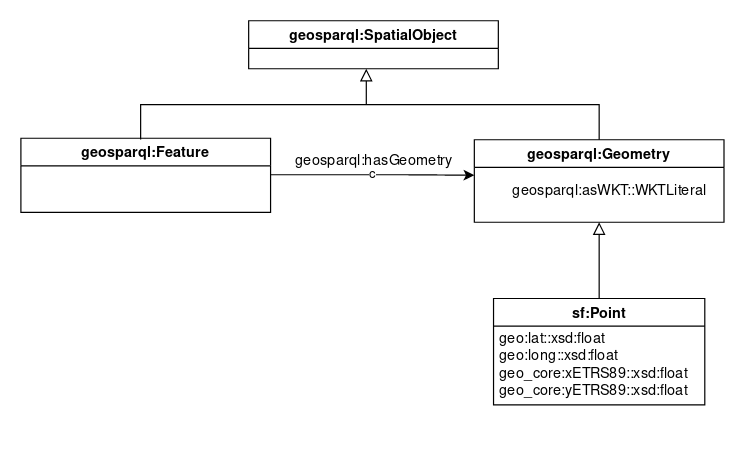
- From the vocabulary geosparql are reused the class geosparql:SpatialObject which is a superclass of Feature geosparql:Feature, which is in turn the superclass of esautob:Parada, and Geometry geosparql:Geometry, which is a superclass in turn of Point sf:Point. It is also used the property hasGeometry geosparql:hasGeometry that relates the Feature geosparql:Feature to its Geometry geosparql:Geometry, whose property asWKT gesoparql:asWKT represents as literals of well-known representation of geometry (WKT) its geometry.
- From the vocabulary of geo_core are represented X geo_core:xETRS89 and Y geo_core:yETRS89.
- From sf are reused the class sf:Point that has the coordinates.
- From geo are represented longitude geo:long and latitude geo:lat.
<http://vocab.ciudadesabiertas.es/recurso/transporte/autobus/point/3086> a sf:Point ; geo_core:xETRS89 "-3.669505941"^^xsd:float ; geo_core:yETRS89 "40.42907106"^^xsd:float ; geosparql:asWKT "POINT (-3.6695059 40.42907106)"^^geosparql:wktLiteral ; geo:lat "40.4290710639788"^^xsd:float ; geo:long "-3.66950594187533"^^xsd:float .
VehicleJourney
The Vehicle Journey tmjourney:VehicleJourney are made using tmjourney:madeUsing tmjourney:JourneyPattern, work on tmjourney:workedOn Day Types tmjourney:DayType, are composed of tmjourney:composedOf Headway Journey Group tmjoruney:HeadwayJourneyGroup and its tmjourney:directionType is a taxonomy of < href="https://w3id.org/transmodel/kos/journeys/direction-type">tmkosjourney:direction-type.
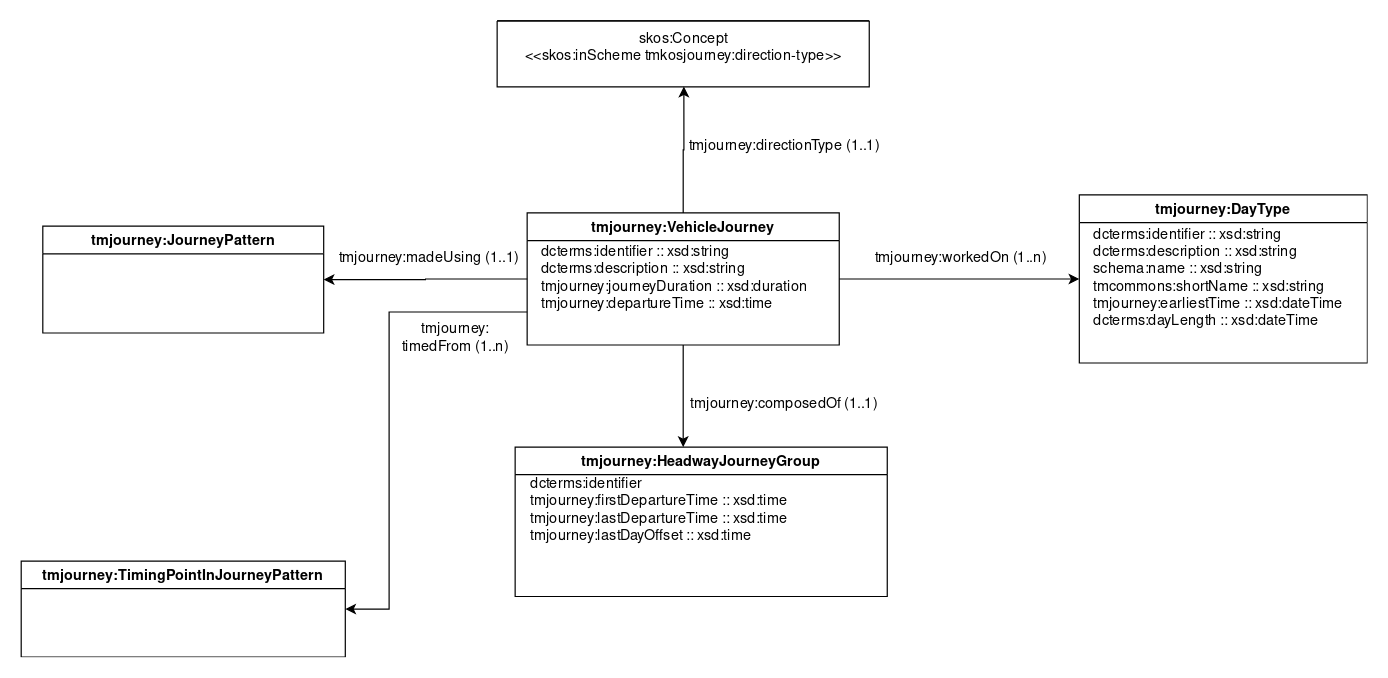
Other properties are:
- The identifier dcterms:identifier, which may be the same as the chosen by the tmjourney:JourneyPattern.
- A description dcterms:description
- Its duration tmjourney:journeyDuration.
- The departure time tmjourney:departureTime.
<http://vocab.ciudadesabiertas.es/recurso/transporte/autobus/vehiclejourney/110a1> a tmjourney:VehicleJourney ;
dcterms:identifier "110a1"^^xsd:string ;
tmjourney:journeyDuration "P1D"^^xsd:duration ;
tmjourney:departureTime "09:00:00+02:00"^^xsd:time ;
tmjourney:madeUsing <http://vocab.ciudadesabiertas.es/recurso/transporte/autobus/journeypattern/110a1> ;
tmjourney:workedOn <http://vocab.ciudadesabiertas.es/recurso/transporte/autobus/daytype/cualquiera> ;
tmjourney:composedOf <http://vocab.ciudadesabiertas.es/recurso/transporte/autobus/headwayjourneygroup/110a1> ;
tmjourney:directionType <http://w3id.org/transmodel/kos/journeys/direction-type/outbound> .
HeadwayJourneyGroup and HeadwayInterval
The tmjourney:VehicleJourney are composed of tmjourney:composedOf Headway Journey Groups tmjoruney:HeadwayJourneyGroup that informs about the first departure time tmjourney:firstDepartureTime, the last departure time tmjourney:lastDepartureTime and the last day offset tmjourney:lastDayOffset.
It is determined by tmjourney:determinedBy a Headway Interval tmjourney:HeadwayInterval that informs about its minimum headway interval tmjourney:minimumHeadwayInterval, its maximum headway interval tmjourney:maximumHeadwayInterval and the scheduled headway interval tmjourney:scheduledHeadwayInterval.
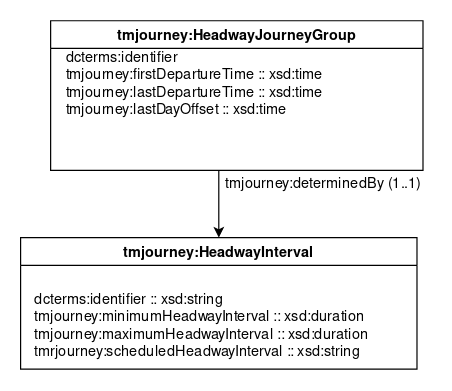
<http://vocab.ciudadesabiertas.es/recurso/transporte/autobus/headwayjourneygroup/138a1-laborable> a tmjourney:HeadwayJourneyGroup ;
dcterms:identifier "138a1-laborable"^^xsd:string ;
tmjourney:firstDepartureTime "06:15:00+02:00"^^xsd:time ;
tmjourney:lastDepartureTime "23:30:00+02:00"^^xsd:time ;
tmjourney:determinedBy <http://vocab.ciudadesabiertas.es/recurso/transporte/autobus/headwayinterval/138-laborable> .
<http://vocab.ciudadesabiertas.es/recurso/transporte/autobus/headwayinterval/138-laborable> a tmjourney:HeadwayInterval ;
tmjourney:minimumHeadwayInterval "P7M"^^xsd:duration ;
tmjourney:maximumHeadwayInterval "P20M"^^xsd:duration ;
tmjourney:scheduledHeadwayInterval "Cada 7 - 20 min."^^xsd:string .
DayType, DayTypeAssignment and ServiceCalendar
Each Service Calendar tmjourney:ServiceCalendar has the properties identifier dcterms:identifier, description dcterms:description, name schema:name, short name tmcommons:shortName the starting date tmjourney:from and the ending date tmjourney:to.
It is defined by tmjourney:definedBy day type assingments tmjourney:DayTypeAssignment which are days specifying tmjourney:specifying Day Types tmjourney:DayType that share the first four properties with Service Calendars tmjourney:ServiceCalendar and have some other own properties as the earliest time tmjourney:earliestTime and the day length dcterms:dayLength.

<http://vocab.ciudadesabiertas.es/recurso/transporte/autobus/servicecalendar/2020> a tmjourney:ServiceCalendar ;
dcterms:identifier "2020"^^xsd:string ;
dcterms:description "Calendario de servicio de la EMT Madrid para 2020"^^xsd:string ;
schema:name "Calendario de servicio de la EMT Madrid para 2020"^^xsd:string ;
tmcommons:shortName "Calendario Servicio EMT Madrid 2020"^^xsd:string ;
tmjourney:from "2020-01-01"^^xsd:date ;
tmjourney:to "2020-12-31"^^xsd:date ;
tmjourney:definedBy <http://vocab.ciudadesabiertas.es/recurso/transporte/autobus/daytypeassignment/20200102> .
<http://vocab.ciudadesabiertas.es/recurso/transporte/autobus/daytypeassignment/20200102> a tmjourney:DayTypeAssignment ;
tmjourney:date "2020-01-02"^^xsd:date ;
tmjourney:isAvailable "true"^^xsd:boolean ;
tmjourney:specifying <http://vocab.ciudadesabiertas.es/recurso/transporte/autobus/daytype/laborable> .
<http://vocab.ciudadesabiertas.es/recurso/transporte/autobus/daytype/laborable> a tmjourney:DayType ;
dcterms:identifier "laborable"^^xsd:string ;
dcterms:description "Horario general para el servicio de EMT en día laborable." ;
schema:name "Día laborable"^^xsd:string ;
tmcommons:shortName "Laborables"^^xsd:string ;
tmjourney:earliestTime "05:30:00"^^xsd:time .
Cross reference for classes, properties and data properties back to ToC
This section provides details for each class and property defined by Vocabulary for the representation of data on public transport by bus.
Classes
- Authority
- Bus Line
- Concept
- Concept Scheme
- Contact Details
- Contact Point
- DayType
- DayTypeAssignment
- Destination Display
- Feature
- Feature Of Interest
- Geographic Point
- Geometry
- Headway Interval
- Headway Journey Group
- Incidence
- JourneyPattern
- Line
- Link Sequence
- Observation
- Operator
- Organisation
- Organization
- Place
- Planned incidence
- Point
- Point In Journey Pattern
- Point in Link Sequence
- Point on Route
- Postal Address
- Presentation
- Route
- Route Point
- Scheduled Stop Point
- Sensor
- ServiceCalendar
- Spatial Object
- Stop Area
- Stop Place
- Stop Point In Journey Pattern
- Timing Point In Journey Pattern
- VehicleJourney
- Waiting Time
- Zone
Authorityc back to ToC or Class ToC
IRI: http://w3id.org/transmodel/organisations#Authority
- has super-classes
- Organisation c
- is in range of
- Serving Public Transport For op
- is disjoint with
- Operator c
Bus Linec back to ToC or Class ToC
IRI: http://vocab.ciudadesabiertas.es/def/transporte/autobus#Linea
- Is defined by
- http://vocab.ciudadesabiertas.es/def/transporte/autobus
- has super-classes
- Line c
- is in domain of
- Line End Stop Point op, Line Head Stop Point op
- is disjoint with
- JourneyPattern c
Conceptc back to ToC or Class ToC
IRI: http://www.w3.org/2004/02/skos/core#Concept
- Is defined by
- http://www.w3.org/2004/02/skos/core#
- is disjoint with
- Concept Scheme c
Concept Schemec back to ToC or Class ToC
IRI: http://www.w3.org/2004/02/skos/core#ConceptScheme
- Is defined by
- http://www.w3.org/2004/02/skos/core#
- is in range of
- It is in Scheme op
- has members
- day type ni, type of direction ni, type of incidence ni, type of stop ni
- is disjoint with
- Concept c
Contact Detailsc back to ToC or Class ToC
IRI: http://w3id.org/transmodel/organisations#ContactDetails
- has super-classes
- Contact Point c
- is in range of
- characterised by op
Contact Pointc back to ToC or Class ToC
IRI: http://schema.org/ContactPoint
- has sub-classes
- Contact Details c
- is in domain of
- E-mail dp, Nombre alternativo dp, Nombre legal dp, Telephone dp
- is in range of
- Contact Point op
DayTypec back to ToC or Class ToC
IRI: http://w3id.org/transmodel/journeys#DayType
- is in domain of
- Earliest Time dp
- is in range of
- specifying op, worked On op
DayTypeAssignmentc back to ToC or Class ToC
IRI: http://w3id.org/transmodel/journeys#DayTypeAssignment
- is in domain of
- Date dp, Is Available dp, specifying op
- is in range of
- defined By op
Destination Displayc back to ToC or Class ToC
IRI: http://w3id.org/transmodel/journeys#DestinationDisplay
- is in domain of
- Front Text dp
- is in range of
- Prescribing op
Featurec back to ToC or Class ToC
IRI: http://www.opengis.net/ont/geosparql#Feature
- Is defined by
- http://www.opengis.net/spec/geosparql
- has super-classes
- Spatial Object c
- has sub-classes
- Incidence c, Stop Place c
Feature Of Interestc back to ToC or Class ToC
IRI: http://www.w3.org/ns/sosa/FeatureOfInterest
- Is defined by
- http://www.w3.org/ns/sosa/
- Example
-
When measuring the height of a tree, the height is the observed ObservableProperty, 20m may be the Result of the Observation, and the tree is the FeatureOfInterest. A window is a FeatureOfInterest for an automatic window control Actuator.
- has sub-classes
- Point in Link Sequence c
- is in range of
- has Feature Of Interest op
Geographic Pointc back to ToC or Class ToC
IRI: http://www.opengis.net/ont/sf#Point
- Is defined by
- http://www.opengis.net/ont/geosparql#
Geometryc back to ToC or Class ToC
IRI: http://www.opengis.net/ont/geosparql#Geometry
- Is defined by
- http://www.opengis.net/spec/geosparql
- has super-classes
- Spatial Object c
- has sub-classes
- Geographic Point c
- is in domain of
- asWKT op
- is in range of
- hasGeometry op
Headway Intervalc back to ToC or Class ToC
IRI: http://w3id.org/transmodel/journeys#HeadwayInterval
- is in domain of
- Maximum Headway Interval dp, Minimum Headway Interval dp, Scheduled Headway Interval dp
- is in range of
- determined By op
Headway Journey Groupc back to ToC or Class ToC
IRI: http://w3id.org/transmodel/journeys#HeadwayJourneyGroup
- is in domain of
- First departure time dp, Last day offset dp, determined By op, last departure time dp
- is in range of
- composed of op
Incidencec back to ToC or Class ToC
IRI: http://vocab.ciudadesabiertas.es/def/transporte/trafico#Incidencia
- Is defined by
- http://vocab.ciudadesabiertas.es/def/transporte/trafico
- has super-classes
- Feature c
- has sub-classes
- Planned incidence c
- is in domain of
- Street directions dp, Traffic lanes dp, attached to incidence dp
- is in range of
- JourneyPattern generated by an Incidenceline affected by an incidence op, line affected by an incidence op
- is disjoint with
- Stop Place c
JourneyPatternc back to ToC or Class ToC
IRI: http://w3id.org/transmodel/journeys#JourneyPattern
- has super-classes
- Link Sequence c
- is in domain of
- JourneyPattern generated by an Incidenceline affected by an incidence op, Prescribing op, on op
- is disjoint with
- Bus Line c
Linec back to ToC or Class ToC
IRI: http://w3id.org/transmodel/journeys#Line
- has super-classes
- has sub-classes
- Bus Line c
- is in domain of
- presented by op
- is in range of
- operating op
Link Sequencec back to ToC or Class ToC
IRI: http://w3id.org/transmodel/journeys#LinkSequence
- has super-classes
- has sub-classes
- JourneyPattern c, Route c
- is in domain of
- Distance dp, made Using op
Observationc back to ToC or Class ToC
IRI: http://www.w3.org/ns/sosa/Observation
- Is defined by
- http://www.w3.org/ns/sosa/
- Example
-
The activity of estimating the intensity of an Earthquake using the Mercalli intensity scale is an Observation as is measuring the moment magnitude, i.e., the energy released by said earthquake.
- has sub-classes
- Waiting Time c
- is in domain of
- Phenomenon Time dp, has Feature Of Interest op, made by sensor op
Operatorc back to ToC or Class ToC
IRI: http://w3id.org/transmodel/organisations#Operator
- has super-classes
- Organisation c
- is in domain of
- Serving Public Transport For op, operating op
- is disjoint with
- Authority c
Organisationc back to ToC or Class ToC
IRI: http://w3id.org/transmodel/organisations#Organisation
- is equivalent to
- Organization c
- has super-classes
- Organization c
- has sub-classes
- Authority c, Operator c
- is in domain of
- characterised by op
Organizationc back to ToC or Class ToC
IRI: http://www.w3.org/ns/org#Organization
- has sub-classes
- Organisation c
Placec back to ToC or Class ToC
IRI: http://w3id.org/transmodel/commons#Place
- has super-classes
- Zone c
- has sub-classes
- Stop Area c, Stop Place c
Planned incidencec back to ToC or Class ToC
IRI: http://vocab.ciudadesabiertas.es/def/transporte/trafico#IncidenciaPlanificada
- Is defined by
- http://vocab.ciudadesabiertas.es/def/transporte/trafico
- has super-classes
- Incidence c
- is in domain of
- (expected) end date dp, Recurrence dp, Recurrent incidence dp
Pointc back to ToC or Class ToC
IRI: http://w3id.org/transmodel/journeys#Point
- has sub-classes
- Route Point c, Scheduled Stop Point c, Timing Point In Journey Pattern c
- is in domain of
- functionalCentroidFor op
- is in range of
- viewed As op
Point In Journey Patternc back to ToC or Class ToC
IRI: http://w3id.org/transmodel/journeys#PointInJourneyPattern
- has super-classes
- Point in Link Sequence c
- has sub-classes
- Stop Point In Journey Pattern c
Point in Link Sequencec back to ToC or Class ToC
IRI: http://w3id.org/transmodel/journeys#PointInLinkSequence
- has super-classes
- Feature Of Interest c
- has sub-classes
- Point In Journey Pattern c, Point on Route c, Timing Point In Journey Pattern c
- is in domain of
- Distance from start dp, Order dp, viewed As op
- is in range of
- made Using op
Point on Routec back to ToC or Class ToC
IRI: http://w3id.org/transmodel/journeys#PointOnRoute
- has super-classes
- Point in Link Sequence c
Postal Addressc back to ToC or Class ToC
IRI: http://vocab.linkeddata.es/datosabiertos/def/urbanismo-infraestructuras/direccion-postal#DireccionPostal
- is in range of
- Has Address op
Presentationc back to ToC or Class ToC
IRI: http://w3id.org/transmodel/commons#Presentation
- has super-classes
- is in domain of
- colour dp, text colour dp
- is in range of
- presented by op
Routec back to ToC or Class ToC
IRI: http://w3id.org/transmodel/journeys#Route
- has super-classes
- Link Sequence c
- is in domain of
- Direction Type op
- is in range of
- on op
Route Pointc back to ToC or Class ToC
IRI: http://w3id.org/transmodel/journeys#RoutePoint
- has super-classes
- Point c
Scheduled Stop Pointc back to ToC or Class ToC
IRI: http://w3id.org/transmodel/journeys#ScheduledStopPoint
- has super-classes
- Point c
- is in domain of
- Included In op, for Alighting dp, for Boarding dp
Sensorc back to ToC or Class ToC
IRI: http://www.w3.org/ns/sosa/Sensor
- Is defined by
- http://www.w3.org/ns/sosa/
- Example
-
Accelerometers, gyroscopes, barometers, magnetometers, and so forth are Sensors that are typically mounted on a modern smart phone (which acts as Platform). Other examples of sensors include the human eyes.
- is in range of
- made by sensor op
ServiceCalendarc back to ToC or Class ToC
IRI: http://w3id.org/transmodel/journeys#ServiceCalendar
- is in domain of
- defined By op, from dp, to dp
Spatial Objectc back to ToC or Class ToC
IRI: http://www.opengis.net/ont/geosparql#SpatialObject
- Is defined by
- http://www.opengis.net/spec/geosparql
Stop Areac back to ToC or Class ToC
IRI: http://w3id.org/transmodel/journeys#StopArea
- has super-classes
- Place c
- is in range of
- Included In op
Stop Placec back to ToC or Class ToC
IRI: http://vocab.ciudadesabiertas.es/def/transporte/autobus#Parada
- Is defined by
- http://vocab.ciudadesabiertas.es/def/transporte/trafico
- has super-classes
- Feature c, Place c
- is in domain of
- Electronic Information Panel dp, WiFi dp
- is in range of
- Line End Stop Point op, Line Head Stop Point op
- is disjoint with
- Incidence c
Stop Point In Journey Patternc back to ToC or Class ToC
IRI: http://w3id.org/transmodel/journeys#StopPointInJourneyPattern
- has super-classes
- Point In Journey Pattern c
- is in domain of
- stop Use op
Timing Point In Journey Patternc back to ToC or Class ToC
IRI: http://w3id.org/transmodel/journeys#TimingPointInJourneyPattern
- has super-classes
- Point c, Point in Link Sequence c
- is in range of
- timedFrom op
VehicleJourneyc back to ToC or Class ToC
IRI: http://w3id.org/transmodel/journeys#VehicleJourney
- is in domain of
- Departure Time dp, Journey Duration dp, composed of op, timedFrom op, worked On op
Waiting Timec back to ToC or Class ToC
IRI: http://vocab.ciudadesabiertas.es/def/transporte/autobus#RealTimePassingTime
- Is defined by
- http://vocab.ciudadesabiertas.es/def/transporte/trafico
- has super-classes
- Observation c
- is in domain of
- Expected Arrival Time dp
Zonec back to ToC or Class ToC
IRI: http://w3id.org/transmodel/commons#Zone
- has sub-classes
- Place c
- is in range of
- functionalCentroidFor op
Object Properties
- asWKT
- characterised by
- composed of
- Contact Point
- defined By
- determined By
- Direction Type
- functionalCentroidFor
- Has Address
- has Feature Of Interest
- hasGeometry
- Included In
- It is in Scheme
- JourneyPattern generated by an Incidenceline affected by an incidence
- line affected by an incidence
- Line End Stop Point
- Line Head Stop Point
- made by sensor
- made Up Of
- made Using
- observed property
- observes
- on
- operating
- Prescribing
- presented by
- Serving Public Transport For
- specifying
- stop Use
- timedFrom
- viewed As
- worked On
asWKTop back to ToC or Object Property ToC
IRI: http://www.opengis.net/ont/geosparql#asWKT
- has domain
- Geometry c
- is also defined as
- data property
characterised byop back to ToC or Object Property ToC
IRI: http://w3id.org/transmodel/organisations#characterisedBy
- has super-properties
- Contact Point op, top object property
- has domain
- Organisation c
- has range
- Contact Details c
composed ofop back to ToC or Object Property ToC
IRI: http://w3id.org/transmodel/journeys#composedOf
- has domain
- VehicleJourney c
- has range
- Headway Journey Group c
Contact Pointop back to ToC or Object Property ToC
IRI: http://schema.org/contactPoint
- has super-properties
- top object property
- has sub-properties
- characterised by op
- has range
- Contact Point c
defined Byop back to ToC or Object Property ToC
IRI: http://w3id.org/transmodel/journeys#definedBy
- has domain
- ServiceCalendar c
- has range
- DayTypeAssignment c
determined Byop back to ToC or Object Property ToC
IRI: http://w3id.org/transmodel/journeys#determinedBy
- has domain
- Headway Journey Group c
- has range
- Headway Interval c
Direction Typeop back to ToC or Object Property ToC
IRI: http://w3id.org/transmodel/journeys#directionType
- has super-properties
- top object property
- has domain
- Route c
- has range
- Concept c and (It is in Scheme op value direction type)
functionalCentroidForop back to ToC or Object Property ToC
IRI: http://w3id.org/transmodel/commons#functionalCentroidFor
- has super-properties
- top object property
- has domain
- Point c
- has range
- Zone c
Has Addressop back to ToC or Object Property ToC
IRI: http://schema.org/address
- has super-properties
- top object property
- has range
- Postal Address c
has Feature Of Interestop back to ToC or Object Property ToC
IRI: http://www.w3.org/ns/sosa/hasFeatureOfInterest
- has super-properties
- top object property
- has domain
- Observation c
- has range
- Feature Of Interest c
hasGeometryop back to ToC or Object Property ToC
IRI: http://www.opengis.net/ont/geosparql#hasGeometry
- has super-properties
- top object property
- has domain
- has range
- Geometry c
Included Inop back to ToC or Object Property ToC
IRI: http://w3id.org/transmodel/journeys#includedIn
- has super-properties
- top object property
- has domain
- Scheduled Stop Point c
- has range
- Stop Area c
It is in Schemeop back to ToC or Object Property ToC
IRI: http://www.w3.org/2004/02/skos/core#inScheme
- Is defined by
- http://www.w3.org/2004/02/skos/core
- has super-properties
- top object property
- has range
- Concept Scheme c
JourneyPattern generated by an Incidenceline affected by an incidenceop back to ToC or Object Property ToC
IRI: http://vocab.ciudadesabiertas.es/def/transporte/autobus#generadoPorIncidencia
- Is defined by
- http://vocab.ciudadesabiertas.es/def/transporte/autobus
- has super-properties
- top object property
- has domain
- JourneyPattern c
- has range
- Incidence c
line affected by an incidenceop back to ToC or Object Property ToC
IRI: http://vocab.ciudadesabiertas.es/def/transporte/autobus#afectadaPorIncidencia
- Is defined by
- http://vocab.ciudadesabiertas.es/def/transporte/autobus
- has super-properties
- top object property
- has domain
- has range
- Incidence c
Line End Stop Pointop back to ToC or Object Property ToC
IRI: http://vocab.ciudadesabiertas.es/def/transporte/autobus#finalLinea
- Is defined by
- http://vocab.ciudadesabiertas.es/def/transporte/autobus
- has super-properties
- top object property
- has domain
- Bus Line c
- has range
- Stop Place c
Line Head Stop Pointop back to ToC or Object Property ToC
IRI: http://vocab.ciudadesabiertas.es/def/transporte/autobus#cabeceraLinea
- Is defined by
- http://vocab.ciudadesabiertas.es/def/transporte/autobus
- has super-properties
- top object property
- has domain
- Bus Line c
- has range
- Stop Place c
made by sensorop back to ToC or Object Property ToC
IRI: http://www.w3.org/ns/sosa/madeBySensor
- Is defined by
- http://www.w3.org/ns/sosa/
- has domain
- Observation c
- has range
- Sensor c
made Up Ofop back to ToC or Object Property ToC
IRI: http://w3id.org/transmodel/journeys#madeUpOf
- has super-properties
- top object property
made Usingop back to ToC or Object Property ToC
IRI: http://w3id.org/transmodel/journeys#madeUsing
- has super-properties
- top object property
- has domain
- Link Sequence c
- has range
- Point in Link Sequence c
observed propertyop back to ToC or Object Property ToC
IRI: http://www.w3.org/ns/sosa/observedProperty
- Is defined by
- http://www.w3.org/ns/sosa/
observesop back to ToC or Object Property ToC
IRI: http://www.w3.org/ns/sosa/observes
- Is defined by
- http://www.w3.org/ns/sosa/
onop back to ToC or Object Property ToC
IRI: http://w3id.org/transmodel/journeys#on
- has super-properties
- top object property
- has domain
- JourneyPattern c
- has range
- Route c
operatingop back to ToC or Object Property ToC
IRI: http://w3id.org/transmodel/organisations#operating
- has super-properties
- top object property
- has domain
- Operator c
- has range
- Line c
Prescribingop back to ToC or Object Property ToC
IRI: http://w3id.org/transmodel/journeys#prescribing
- has super-properties
- top object property
- has domain
- JourneyPattern c
- has range
- Destination Display c
presented byop back to ToC or Object Property ToC
IRI: http://w3id.org/transmodel/journeys#presentedBy
- has domain
- Line c
- has range
- Presentation c
Serving Public Transport Forop back to ToC or Object Property ToC
IRI: http://w3id.org/transmodel/organisations#servingPTFor
- has super-properties
- top object property
- has domain
- Operator c
- has range
- Authority c
specifyingop back to ToC or Object Property ToC
IRI: http://w3id.org/transmodel/journeys#specifying
- has super-properties
- top object property
- has domain
- DayTypeAssignment c
- has range
- DayType c
stop Useop back to ToC or Object Property ToC
IRI: http://w3id.org/transmodel/journeys#stopUse
- has super-properties
- top object property
- has domain
- Stop Point In Journey Pattern c
- has range
- Concept c and (It is in Scheme op value stop use type)
timedFromop back to ToC or Object Property ToC
IRI: http://w3id.org/transmodel/journeys#timedFrom
- has super-properties
- top object property
- has domain
- VehicleJourney c
- has range
- Timing Point In Journey Pattern c
viewed Asop back to ToC or Object Property ToC
IRI: http://w3id.org/transmodel/journeys#viewedAs
- has super-properties
- top object property
- has domain
- Point in Link Sequence c
- has range
- Point c
worked Onop back to ToC or Object Property ToC
IRI: http://w3id.org/transmodel/journeys#workedOn
- has super-properties
- top object property
- has domain
- VehicleJourney c
- has range
- DayType c
Data Properties
- (expected) end date
- (expected) start date
- attached to incidence
- colour
- Date
- Date created
- Date posted
- Departure Time
- Description
- Distance
- Distance from start
- Earliest Time
- Electronic Information Panel
- end date
- Expected Arrival Time
- First departure time
- for Alighting
- for Boarding
- from
- Front Text
- Identifier
- Is Available
- Journey Duration
- Last day offset
- last departure time
- latitude
- longitude
- Maximum Headway Interval
- Minimum Headway Interval
- Nombre
- Nombre alternativo
- Nombre legal
- Order
- Phenomenon Time
- Recurrence
- Recurrent incidence
- Scheduled Headway Interval
- Short Name
- Street directions
- Telephone
- text colour
- to
- Traffic lanes
- URL
- WiFi
- xETRS89
- yETRS89
- Zone
(expected) end datedp back to ToC or Data Property ToC
IRI: http://vocab.ciudadesabiertas.es/def/transporte/trafico#fechaFinPrevista
- Is defined by
- http://schema.org/
- has domain
- Planned incidence c
- has range
- date time
(expected) start datedp back to ToC or Data Property ToC
IRI: http://schema.org/startDate
- Is defined by
- http://schema.org/
- has range
- date time
attached to incidencedp back to ToC or Data Property ToC
IRI: http://vocab.ciudadesabiertas.es/def/transporte/trafico#incidenciaAdjunto
- Is defined by
- http://vocab.ciudadesabiertas.es/def/transporte/trafico
colourdp back to ToC or Data Property ToC
IRI: http://w3id.org/transmodel/commons#colour
- has domain
- Presentation c
- has range
- string
Datedp back to ToC or Data Property ToC
IRI: http://w3id.org/transmodel/journeys#date
- has super-properties
- top data property
- has domain
- DayTypeAssignment c
- has range
- date time
Date createddp back to ToC or Data Property ToC
IRI: http://schema.org/dateCreated
- Is defined by
- http://schema.org/
- has range
- date time
Date posteddp back to ToC or Data Property ToC
IRI: http://schema.org/datePosted
- Is defined by
- http://schema.org/
- has range
- date time
Departure Timedp back to ToC or Data Property ToC
IRI: http://w3id.org/transmodel/journeys#departureTime
- has super-properties
- top data property
- has domain
- VehicleJourney c
- has range
- date time
Descriptiondp back to ToC or Data Property ToC
IRI: http://purl.org/dc/terms/description
- Is defined by
- http://purl.org/dc/terms/
- has range
- string
Distancedp back to ToC or Data Property ToC
IRI: http://w3id.org/transmodel/journeys#distance
- has super-properties
- top data property
- has domain
- Link Sequence c
- has range
- double
Distance from startdp back to ToC or Data Property ToC
IRI: http://w3id.org/transmodel/journeys#distanceFromStart
- has super-properties
- top data property
- has domain
- Point in Link Sequence c
- has range
- double
E-maildp back to ToC or Data Property ToC
IRI: http://schema.org/email
- Is defined by
- http://schema.org/
- has domain
- Contact Point c
- has range
- string
Earliest Timedp back to ToC or Data Property ToC
IRI: http://w3id.org/transmodel/journeys#earliestTime
- has super-properties
- top data property
- has domain
- DayType c
- has range
- date time
Electronic Information Paneldp back to ToC or Data Property ToC
IRI: http://vocab.ciudadesabiertas.es/def/transporte/autobus#panelElectronico
- has super-properties
- top data property
- has domain
- Stop Place c
- has range
- boolean
end datedp back to ToC or Data Property ToC
IRI: http://schema.org/endDate
- Is defined by
- http://schema.org/
- has range
- date time
Expected Arrival Timedp back to ToC or Data Property ToC
IRI: http://vocab.ciudadesabiertas.es/def/transporte/autobus#expectedArrivalTime
- has super-properties
- top data property
- has domain
- Waiting Time c
- has range
- duration
First departure timedp back to ToC or Data Property ToC
IRI: http://w3id.org/transmodel/journeys#firstDepartureTime
- has super-properties
- top data property
- has domain
- Headway Journey Group c
- has range
- date time
for Alightingdp back to ToC or Data Property ToC
IRI: http://w3id.org/transmodel/journeys#forAlighting
- has super-properties
- top data property
- has domain
- Scheduled Stop Point c
- has range
- boolean
for Boardingdp back to ToC or Data Property ToC
IRI: http://w3id.org/transmodel/journeys#forBoarding
- has super-properties
- top data property
- has domain
- Scheduled Stop Point c
- has range
- boolean
fromdp back to ToC or Data Property ToC
IRI: http://w3id.org/transmodel/journeys#from
- has super-properties
- top data property
- has domain
- ServiceCalendar c
- has range
- date
Front Textdp back to ToC or Data Property ToC
IRI: http://w3id.org/transmodel/journeys#frontText
- has domain
- Destination Display c
- has range
- string
Identifierdp back to ToC or Data Property ToC
IRI: http://purl.org/dc/terms/identifier
- Is defined by
- http://purl.org/dc/terms/
- has range
- string
Is Availabledp back to ToC or Data Property ToC
IRI: http://w3id.org/transmodel/journeys#isAvailable
- has super-properties
- top data property
- has domain
- DayTypeAssignment c
- has range
- boolean
Journey Durationdp back to ToC or Data Property ToC
IRI: http://w3id.org/transmodel/journeys#journeyDuration
- has super-properties
- top data property
- has domain
- VehicleJourney c
- has range
- date time
Last day offsetdp back to ToC or Data Property ToC
IRI: http://w3id.org/transmodel/journeys#lastDayOffset
- has super-properties
- top data property
- has domain
- Headway Journey Group c
- has range
- date time
last departure timedp back to ToC or Data Property ToC
IRI: http://w3id.org/transmodel/journeys#lastDepartureTime
- has super-properties
- top data property
- has domain
- Headway Journey Group c
- has range
- date time
latitudedp back to ToC or Data Property ToC
IRI: http://www.w3.org/2003/01/geo/wgs84_pos#lat
- has domain
- Geographic Point c
- has range
- float
longitudedp back to ToC or Data Property ToC
IRI: http://www.w3.org/2003/01/geo/wgs84_pos#long
- has domain
- Geographic Point c
- has range
- float
Maximum Headway Intervaldp back to ToC or Data Property ToC
IRI: http://w3id.org/transmodel/journeys#maximumHeadwayInterval
- has super-properties
- top data property
- has domain
- Headway Interval c
- has range
- date time
Minimum Headway Intervaldp back to ToC or Data Property ToC
IRI: http://w3id.org/transmodel/journeys#minimumHeadwayInterval
- has super-properties
- top data property
- has domain
- Headway Interval c
- has range
- date time
Nombredp back to ToC or Data Property ToC
IRI: http://schema.org/name
- Is defined by
- http://schema.org/
- has range
- string
Nombre alternativodp back to ToC or Data Property ToC
IRI: http://schema.org/alternateName
- Is defined by
- http://schema.org/
- has domain
- Contact Point c
- has range
- string
Nombre legaldp back to ToC or Data Property ToC
IRI: http://schema.org/legalName
- Is defined by
- http://schema.org/
- has domain
- Contact Point c
- has range
- string
Orderdp back to ToC or Data Property ToC
IRI: http://w3id.org/transmodel/journeys#order
- has super-properties
- top data property
- has domain
- Point in Link Sequence c
- has range
- non negative integer
Phenomenon Timedp back to ToC or Data Property ToC
IRI: http://www.w3.org/ns/sosa/resultTime
- has super-properties
- top data property
- has domain
- Observation c
- has range
- date time
Recurrencedp back to ToC or Data Property ToC
IRI: http://vocab.ciudadesabiertas.es/def/transporte/trafico#recurrencia
- has super-properties
- top data property
- has domain
- Planned incidence c
- has range
- string
Recurrent incidencedp back to ToC or Data Property ToC
IRI: http://vocab.ciudadesabiertas.es/def/transporte/trafico#esRecurrente
- has super-properties
- top data property
- has domain
- Planned incidence c
- has range
- boolean
Scheduled Headway Intervaldp back to ToC or Data Property ToC
IRI: http://w3id.org/transmodel/journeys#scheduledHeadwayInterval
- has super-properties
- top data property
- has domain
- Headway Interval c
- has range
- date time
Short Namedp back to ToC or Data Property ToC
IRI: http://w3id.org/transmodel/commons#shortName
- has super-properties
- top data property
- has domain
- Line c
- has range
- string
Street directionsdp back to ToC or Data Property ToC
IRI: http://vocab.ciudadesabiertas.es/def/transporte/trafico#numSentidos
- Is defined by
- http://vocab.ciudadesabiertas.es/def/transporte/trafico
Telephonedp back to ToC or Data Property ToC
IRI: http://schema.org/telephone
- Is defined by
- http://schema.org/
- has domain
- Contact Point c
- has range
- string
text colourdp back to ToC or Data Property ToC
IRI: http://w3id.org/transmodel/commons#textColour
- has domain
- Presentation c
- has range
- string
todp back to ToC or Data Property ToC
IRI: http://w3id.org/transmodel/journeys#to
- has super-properties
- top data property
- has domain
- ServiceCalendar c
- has range
- date
Traffic lanesdp back to ToC or Data Property ToC
IRI: http://vocab.ciudadesabiertas.es/def/transporte/trafico#numCarriles
- Is defined by
- http://vocab.ciudadesabiertas.es/def/transporte/trafico
URLdp back to ToC or Data Property ToC
IRI: http://schema.org/url
- Is defined by
- http://schema.org/
- has range
- any u r i
WiFidp back to ToC or Data Property ToC
IRI: http://vocab.ciudadesabiertas.es/def/transporte/autobus#wifi
- has super-properties
- top data property
- has domain
- Stop Place c
- has range
- boolean
xETRS89dp back to ToC or Data Property ToC
IRI: https://datos.ign.es/def/geo_core#xETRS89
- has domain
- Geographic Point c
- has range
- float
yETRS89dp back to ToC or Data Property ToC
IRI: https://datos.ign.es/def/geo_core#yETRS89
- has domain
- Geographic Point c
- has range
- float
Zonedp back to ToC or Data Property ToC
IRI: http://vocab.ciudadesabiertas.es/def/transporte/autobus#zona
- has super-properties
- top data property
- has domain
- has range
- string
Named Individuals
day typeni back to ToC or Named Individual ToC
IRI: http://w3id.org/transmodel/kos/journeys/day-type
- belongs to
- Concept Scheme c
type of directionni back to ToC or Named Individual ToC
IRI: http://w3id.org/transmodel/kos/journeys/direction-type/
- belongs to
- Concept Scheme c
type of incidenceni back to ToC or Named Individual ToC
IRI: http://vocab.linkeddata.es/datosabiertos/kos/transporte/trafico/tipo-incidencia
- belongs to
- Concept Scheme c
type of stopni back to ToC or Named Individual ToC
IRI: http://w3id.org/transmodel/kos/journeys/stop-use-type/
- belongs to
- Concept Scheme c
Legend back to ToC
op: Object Properties
dp: Data Properties
ni: Named Individuals
References back to ToC
The vocabulary of the urban public bus transport service mainly uses the modules of the Transmodel vocabulary, relies on other vocabularies (sosa, geo, kos and organization) as well as creating some ad hoc classes and properties.
In particular, from Transmodel the following vocabularies have been reused:
- Commons, tmcommons, to represent some common concepts and properties of the Transmodel modules.
- Journeys, tmjourneys, to represent the information related to journeys.
- Organisations, tmorg, to represent the information relate to the organisations that participate in the urban bus public transport system.
The other vocabularies that have been employed are:
- To represent taxonomies, SKOS (Simple Knowledge Organization System), in particular:
- tmkoscommons for common taxonomies.
- tmkosjourney for journey taxonomies.
- For the geographic representation of data there have been reused the following vocabularies:
- For some bus or route values, the sensor vocabulary SOSA (Semantic Sensor Network Ontology) has been reused.
- The Traffic vocabulary has been reused estraf for incidents.
- For the stop address the street vocabulary escjr has been reused.
- For transport organisations the org vocabulary has been reused.
Acknowledgments back to ToC
The authors would like to thank Silvio Peroni for developing LODE, a Live OWL Documentation Environment, which is used for representing the Cross Referencing Section of this document and Daniel Garijo for developing Widoco, the program used to create the template used in this documentation; to María Poveda for developing Oops (OntOlogy Pitfall Scanner), the software used to detect common pitfails in the ontology; to Eric Prudhommeaux for its validation RDF service; to IDLab - Ghent University for its Turtle validator.





-blue.svg)
